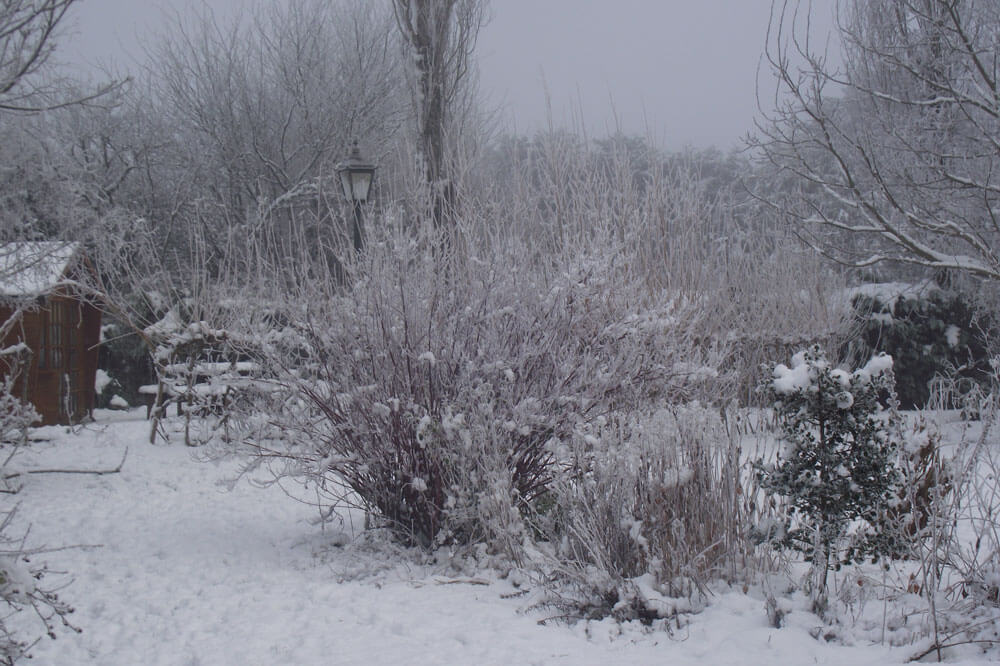The nutrients your lawn needs and when to apply
In the world of plants and gardening, your lawn is the equivalent of a long distance runner. It has stamina, it takes a lot of wear and tear and it works hard. Just like an athlete, if it is poorly nourished performance will suffer. With the right lawn feed at the right times, you will get the best possible results all year round.
Why does your lawn need feeding?
I don’t want to blind you with science, so I won’t go into great detail. Grass plants need nutrients to help them live, grow and stay healthy. Same as you and me. Only grass plants can’t nip to the shops to buy their food. They rely entirely on sunshine, soil and water for everything they need. If the soil doesn’t contain the right balance of nutrients, the plants won’t thrive.

A well fed lawn has a strong plant population, nice even colour and texture and a vibrant healthy colour.
This lawn in Belfast has regular applications of seasonal lawn feed supplemented twice a year with an organic seaweed tonic
Maintaining the right balance of soil nutrients
It’s very easy to look at the grasses growing at the side of the road and conclude that if they look OK without any feed then so will your lawn. If you look closer at the wild grasses though, you’ll see that they’re not really what you would want in your garden. They often have broad, coarse leaves, the plants are spaced quite wide apart and some of them have a lumpy tufty sort of growth habit.
Lawn grasses on the other hand are fine leaved and closely spaced. That’s how they give you a nice even, velvety texture.
The way that plants look, behave and space themselves is mainly down to genetics and the balance of nutrients in the soil. There are also some external factors such as wear and tear, weather patterns, light levels and mowing regime.
Because a lawn consists of an unnaturally large number of plants per square metre and because we ask so much more of them, lawn grasses need a lot more nutrients than wild grasses. In the same way as a professional lawn care person like me, working hard all day outdoors in all weathers needs more bacon sandwiches than someone with a more sedentary lifestyle.
Wear and tear along with regular mowing, disrupts the natural balance between plants and soils. So it’s up to gardeners to do what they can to restore that balance. That means aeration, scarification and yes, you guessed it, feeding.

Mowing your lawn is an essential part of maintenance and it’s what creates that beautiful velvety texture.
Use a combination of really good lawn feed and a mineral rich organic tonic to promote strong healthy regrowth.
Getting your lawn’s diet right
Humans are lucky in that we need fairly constant levels of nutrients all year round. We protect ourselves from the weather and carry on regardless of the season. Lawns are different. All outdoor plants are subject to seasonal changes in their growth. You see, all a grass plant wants to do in life is to procreate. It wants to form seeds and spread them about so they can make new plants. The “mother plant” wants the seeds to have the best chance of survival and so it works with the seasons to create them at the best time of year.
As lawn makers we disrupt the seed setting process by mowing – but the plants’ growth phrases and nutritional needs remain unchanged.

A professional standard lawn fertiliser spreader is quite an investment but well worth it.
If lawn feed is applied unevenly it can result in overdosing some areas, underfeeding other areas and a very mottled appearance overall.
Spring
Soil warms up, soil microbes become more active, daylight hours get longer and the plants grow fast. At this stage, grass needs lots of everything. Nitrogen, phosphorus, potassium, sulphur, iron and all those other micronutrients. If they’re not freely available in the soil, the plant will probably survive, but it won’t thrive.
Feed from late February with a spring-summer feed and for best possible plant health, supplement it with a foliar feed. Foliar feeds are absorbed quickly and a great source of Iron. Iron gives plants their green colour, helps fight disease and also supresses moss in lawns.
Lawn nutrients get used up quickly in spring, so feed every 8-10 weeks and if you can, top up in between times with a foliar feed. Especially if you are carrying out renovations or if you like to keep your lawn close-mown.
Summer
Growth naturally slows down slightly. By now, if we hadn’t have mown them off, the grass plants will have formed seeds on long stalks and those seeds would be getting fatter and ripening. Wheat and Barley are grasses – if you want to see what Mother Nature wants your lawn grass to do – just look at the farmers’ fields all around County Antrim. You’ll see that the corn has ears on it and that they’re changing colour as they ripen.
In summer, you need to make the same nutrients available to your lawn as they had in spring. The days are long and if there’s plenty of moisture in the soil you’ll be able to convince the grass that it’s still April so that the plants stay green. If you aerated your lawn in spring, you’ll see the benefit of it now.
Autumn
As daylight hours get shorter, the soil cools a little and there’s more moisture about, the plants know it’s time to prepare for winter. Grass doesn’t want to get to lush just before winter time. It is a hardy plant but it knows that lots of soft sappy growth could be susceptible to frost damage. So it puts its energy into toughening up.
Go easy on applying nitrogen to your lawn at this time of year. If you are using a proprietary lawn feed, switch to an autumn-winter formulation.
This is when grass really does benefit from a foliar feed with lots and lots of minerals in it. Foliar feed means that it’s applied directly to the leaves and gets absorbed quickly. Minerals are the equivalent of the vitamin supplements we take in winter time to ward off colds and flu.
A low nitrogen feed in autumn – before the frosts really set in – is worth its weight in gold. It’ll make sure the plants enter a cold snap in prime condition. If they start off healthy, they’ll not be hit hard by the frost and you’ll be rewarded with a stunning lawn all year round.
I also thoroughly recommend applying a supplementary seaweed feed sometime between late October and early December. The plants are still growing slowly but they are less able to absorb nutrients from the soil. The foliar feed gives them a much needed dose of minerals to boost their resistance to winter diseases such as fusarium patch and redthread.
Winter
Grass doesn’t stop growing in the winter. OK, the leaves grow slower and you won’t need to mow as often as you did in summer, but while the soil temperature is at 6 degrees or more, the roots will keep on growing and working to support the plant.

Even in the depths of winter, your lawn is still growing. Snow is a very effective insulator. The soil beneath this lawn is probably still warm enough to support root growth.
Winter is when the lawnlover’s arch nemisis really shows itself. Moss. Moss loves winter weather. It’s a primative plant that needs to release spores into a thin layer of water in order to reproduce. In Northern Ireland’s climate, it’s pretty difficult to avoid water on the lawn in winter time. It’s also harder for grass to outcompete moss when its in its winter growth phrase.
Winter time calls for a two-fold approach for tackling moss. 1. weaken the moss plants and 2. strengthen the grass plants. And we greenkeepers know exactly how to do both of those things at the same time. Iron. Iron is a fabulous element, much loved by the gardeners of yore but rarely seen on the shelves of the garden centre. Greenkeepers make full use of it though. Have you ever wondered how golf greens look so good in the depths of winter? Iron. Usually in the form of a liquid treatment because that’s what gets absorbed the quickest.
As well as controlling moss, Iron gives lawn grasses a much deeper, greener colour and keeps them looking really vibrant and healthy. I like to apply it in January. More often than not, lawns treated with Iron stand out from every other lawn on the street. They look amazing and are the main focus of the garden until the spring flowering bulbs appear in early march.
Which is the very best feed for my lawn?
Most lawn modern lawn feeds are a very complicated mix of chemicals. Yes. You read it right. Chemicals. In the wrong hands, chemicals can be nasty things, which is why the lawn feeds and lawn treatments you’ll find on sale in the garden centre are a lot less concentrated than the ones that are available to trained professionals. For the most part you will be buying either filler (if it’s a granulated or powdered lawn feed) or water (liquid feeds) with small amounts of nutrient added in. You’ll also be paying premium prices for the pretty packaging it comes in.
At Premier lawns, we have the training, the specially calibrated equipment and the knowhow to apply the right balance of lawn nutrients at the right time of year. That means that we able to buy and use far superior products to the ones you’ll find at the local DIY store.
Each of my client’s lawns are treated individually. I don’t offer a “one size fits all” treatment. But in general, I like to apply a seasonally appropriate feed in mid-winter, early spring, late spring, summer and autumn.
Lawn tonic improves winter hardiness and speeds recovery from spring renovations
In late autumn, just as the leaves are falling from the trees, I like to apply an organic seaweed tonic to the lawn. That’s the time of year when you will most likely be thinking about vitamin supplements for yourself to help you through the winter. Well, just like your body, your lawn will also thank you for a dose of concentrated goodness.
The tonic I use is 100% natural and organic. It’s a liquid that is precision sprayed onto the lawn. Most of it gets absorbed through the leaves where it helps with winter hardiness, colour and disease resistance. Some of the tonic finds its way into the soil where it nourishes those all-important soil microbes – the ones that help break down dead matter and turn it into plant food for the next spring.
Where your lawn is either recovering from disease, in the process of being renovated or just needs to look super-fantastic and fast – I’d recommend applying the same tonic in spring and summer too. I use it on my own lawn and the results are amazing.
What does professional lawn feed cost?
Less than you might think! Treatments start from just £15 – not much more than you’d pay for garden centre fertiliser AND you get expert advice for free.
Contact Premier Lawns for a free assessment of your lawns nutritional needs and a no obligation quotation.
Contact Robbie at Premier Lawns
Comments